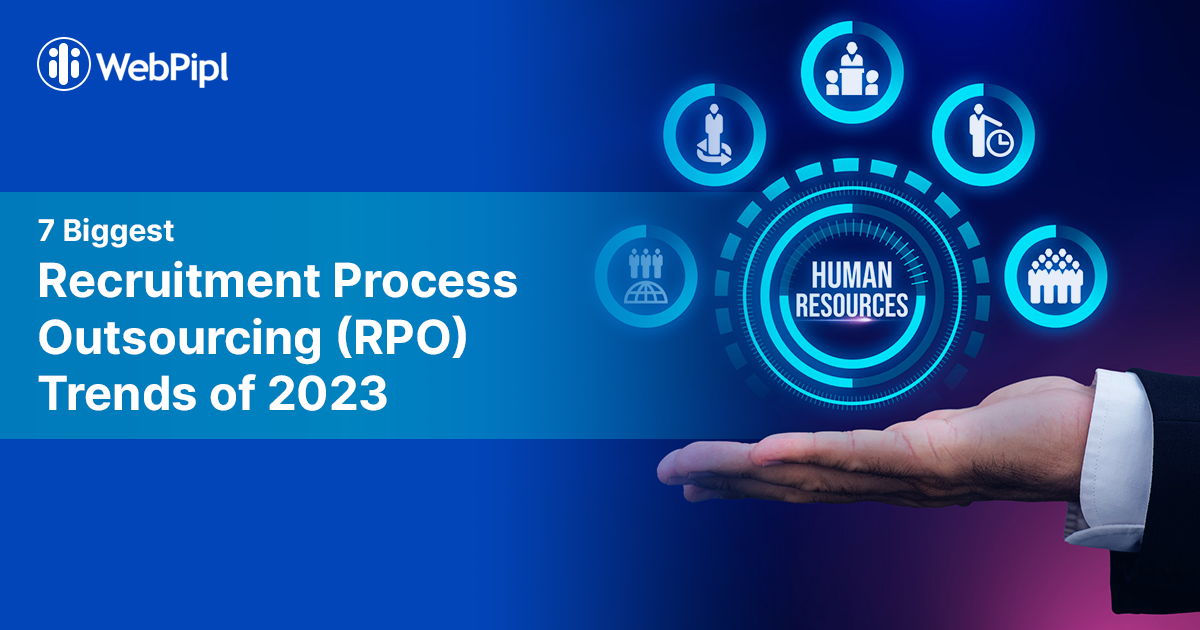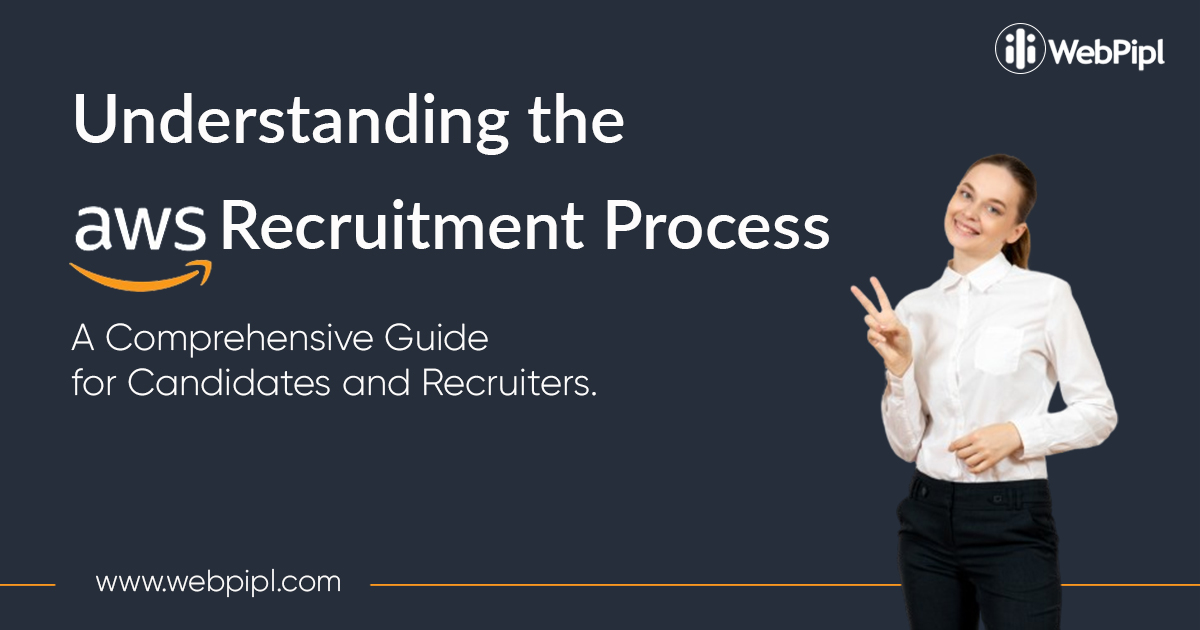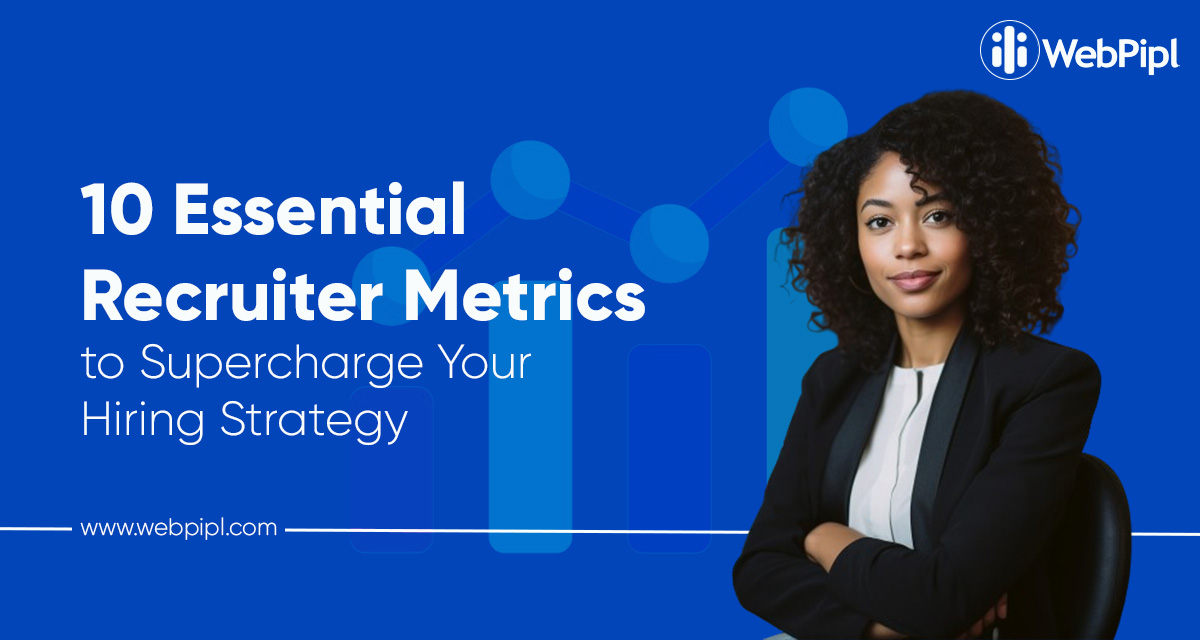Do you want to stay updated on the recent RPO trends that are going to be huge in 2023 and beyond?
This guide has you covered.
After helping dozens of organizations and startups in the recruitment and hiring process, we have learned these important recruitment process outsourcing trends.
In this guide, you will learn:
What is recruitment process outsourcing (RPO)?
Recruitment process outsourcing (RPO) refers to the approach when an organization outsources its recruitment and hiring activities to an external recruiter service provider. For example, at WebPipl, we offer recruitment as a service and help companies hire top talent.
Recruitment outsourcing involves recruitment activities such as:
- Candidate sourcing
- Candidate job screening
- Candidate engagement
- Hiring specialized service providers
RPO aims to enhance recruitment efficiency, reduce costs, and improve the quality of hires.
By leveraging the expertise and resources of RPO providers, companies can streamline their recruitment efforts and focus on core business objectives.
Recruitment process outsourcing trends of 2023
The recruitment landscape is constantly evolving, and staying updated with the latest trends is crucial for recruiters and HR managers. In this blog, we will explore the top recruitment process outsourcing (RPO) trends of 2023.
These trends are shaping the way organizations approach their talent acquisition strategies and optimize their recruitment processes. From leveraging advanced technologies to enhancing candidate experience, each trend presents unique opportunities and hiring challenges.
Let’s delve into the key RPO trends and discover how recruiters can adapt and thrive in this dynamic environment.
Learn what talent acquisition partner is and what are the roles In recruiting
Trend 1: AI-powered Recruitment Tools

What this is all about: AI technology is revolutionizing the recruitment process by automating manual tasks, improving candidate screening accuracy, and enhancing overall efficiency. According to a study by Deloitte, 71% of organizations are actively using AI in their recruitment process.
We have already covered the top tech companies using AI and NLP technologies to improve their recruitment workflow. These companies include IBM, Uniliver, Amazon, Procter & Gamble (P&G), and more.
Why this trend will continue in 2023: The increasing demand for speed, accuracy, and scalability in talent acquisition is driving the adoption of AI-powered recruitment tools.
These tools can streamline the sourcing and screening process, enabling recruiters to identify the best-fit candidates more effectively.
In fact, there are
What recruiters should do about it: Embracing AI-enabled tools like WebPipl can help recruiters automate repetitive tasks, leverage data-driven insights, and improve the quality of their hiring decisions.
By utilizing AI technology, recruiters can focus more on building relationships with candidates and creating a personalized recruitment experience.
Use WebPipl’s AI recruitment software for recruiters that helps you improve interview scheduling, video interviews, resume screening, and more.
Related term: Definition of Interview as a Service (IaaS)
Trend 2: Virtual Hiring and Onboarding

What this is all about: The COVID-19 pandemic has accelerated the shift towards virtual hiring and onboarding processes.
From video interviews to remote onboarding, organizations are leveraging technology to overcome geographical barriers and ensure business continuity.
Why this trend will continue in 2023: Even as the world recovers from the pandemic, remote work and virtual interactions are becoming more prevalent.
Organizations are recognizing the benefits of remote hiring, such as increased access to a global talent pool and reduced costs associated with in-person interviews.
What recruiters should do about it: Recruiters should adapt their hiring processes to accommodate virtual interactions and leverage tools like iVerified for seamless video interviews.
They should also enhance their onboarding programs to create a positive remote onboarding experience for new hires.
Check out iVerified, world’s fastest video interview tool designed for tech recruiters with instant feedback and interview system.
Trend 3: Focus on Diversity and Inclusion

What this is all about: Diversity and inclusion have emerged as crucial factors in mass recruitment.
Organizations are actively working towards building diverse teams and fostering inclusive cultures to drive innovation and better business outcomes.
Why this trend will continue in 2023: Studies have shown that diverse teams outperform homogeneous teams in terms of creativity and problem-solving.
As organizations recognize diversity’s value, they prioritize inclusive recruitment practices to attract candidates from diverse backgrounds.
What recruiters should do about it: Recruiters should implement strategies to attract diverse candidates, such as creating inclusive job descriptions, expanding sourcing channels, and leveraging diversity-focused platforms. They should also review their selection processes to ensure fairness and minimize bias.
Check out our detailed guide on the latest talent acquisition trends that highlight how diversity in hiring is going to play a huge role in candidate hiring.
Trend 4: Enhanced Candidate Experience
What this is all about: Candidate experience refers to the overall perception and interaction that candidates have throughout the recruitment process.
Organizations are focusing on providing a positive and personalized candidate experience to attract and retain top talent.
Why this trend will continue in 2023: In today’s competitive talent market, candidates have high expectations for a seamless and engaging recruitment experience. Organizations that prioritize candidate experience can differentiate themselves and attract top-quality candidates.
What recruiters should do about it: Recruiters should invest in technologies like Applicant Tracking System (ATS) software to streamline the application process, provide timely communication, and personalize interactions.
They should also gather feedback from candidates and continuously improve the recruitment experience.
Trend 5: Remote and Hybrid Workforce
What this is all about: The COVID-19 pandemic has accelerated the shift towards remote and hybrid work models.
Companies are embracing the flexibility and cost-saving benefits of remote work, allowing employees to work from anywhere and enabling a geographically diverse talent pool.
Why this trend will continue in 2023: Many organizations have now understood the importance of allowing Remote work to their employees to enhance productivity, and employee satisfaction and also reduce attrition rates.
Companies are reevaluating their traditional office-centric work models and embracing remote and hybrid setups to attract and retain top talent, reduce overhead costs, and enhance work-life balance for employees.
What recruiters should do about it: Recruiters should adapt their sourcing and onboarding strategies to accommodate remote hiring.
They should focus on assessing candidates’ ability to work independently, communicate effectively in virtual environments, and adapt to changing work dynamics.
Additionally, recruiters should leverage technology tools and platforms that facilitate remote collaboration, communication, and performance evaluation.
To improve your virtual hiring, check out our strategy for hiring top talents via digital recruitment.
Trend 6: Data-Driven Recruitment
What this is all about: Data-driven recruitment involves leveraging analytics and insights to make informed hiring decisions.
Recruiters are utilizing data to identify recruitment patterns, optimize sourcing channels, measure the effectiveness of their strategies, and predict future talent needs.
Why this trend will continue in 2023: In today’s digital age, the abundance of recruitment data and the advancements in analytics technology have opened new doors for data-driven recruitment practices.
Companies already started to recognize the value of data in making informed hiring decisions and it is obvious that the trend will continue to grow.
What recruiters should do about it: It is suggested that recruiters invest in data driven recruitment analysis tools which will provide actionable insights for their hiring process and prove that the return on investment is great.
Yes, with a good data-driven recruitment tool, we can track key recruitment metrics such as time-to-fill, cost-per-hire, and quality-of-hire, to identify areas for improvement.
Trend 7: Employer Branding and Candidate Experience
What this is all about: Employer branding refers to the reputation and image of an organization as an employer.
Candidate experience encompasses the entire journey of a candidate from initial engagement to onboarding. Both factors significantly impact a company’s ability to attract and retain top talent.
Why this trend will continue in 2023: In today’s competitive talent market, candidates have higher expectations and seek organizations that align with their values and offer a positive experience.
Employer branding helps companies differentiate themselves and attract quality candidates. Moreover, a positive candidate experience not only improves candidate satisfaction but also enhances the organization’s reputation and increases the likelihood of candidates accepting job offers.
What recruiters should do about it: Recruiters should collaborate with marketing and HR teams to develop and promote a compelling employer brand that highlights the organization’s values, culture, and employee benefits.
They should focus on delivering a seamless and personalized candidate experience at every touchpoint, from job postings and application process to interviews and feedback.
By prioritizing employer branding and candidate experience, recruiters can create a competitive advantage and attract top talent to their organizations.
These are just a few of the top recruitment process outsourcing trends of 2023. By staying informed and embracing these trends, recruiters can navigate the evolving landscape of talent acquisition.
What is the growth of Recruitment Process Outsourcing?
The growth of recruitment process outsourcing (RPO) has been remarkable in recent years.
This growth can be attributed to several factors, including the increasing need for cost-effective and efficient talent acquisition solutions, the rising demand for specialized recruitment expertise, and the focus on optimizing recruitment processes to attract and retain top talent.
As organizations recognize the benefits of outsourcing their recruitment functions, the RPO industry is expected to witness continued expansion in the coming years.
How big is the recruitment process outsourcing market?
The recruitment process outsourcing (RPO) market has witnessed substantial growth in recent years, driven by factors such as the increasing demand for streamlined recruitment processes, cost optimization, and access to specialized expertise offered by RPO providers.
This market is projected to continue its upward trajectory, presenting significant opportunities for organizations to enhance their recruitment strategies and gain a competitive edge.
Is outsourcing an effective method of recruitment?
Yes, outsourcing can be an effective method of recruitment for many organizations. By partnering with a reputable recruitment process outsourcing (RPO) provider, companies can leverage their expertise and resources to streamline the recruitment process, improve the quality of hires, and reduce time-to-fill positions.
RPO providers bring specialized knowledge in sourcing, screening, and attracting top talent, along with access to advanced recruitment technologies.
This allows companies to focus on their core business functions while entrusting the recruitment process to experts.
However, the effectiveness of outsourcing depends on factors such as the organization’s specific needs, the capabilities of the RPO provider, and effective communication and collaboration between the client and the RPO partner.
How do you keep up with recruitment trends?
By actively engaging in these activities, HR professionals can stay informed about the latest recruitment trends, adapt their strategies, and make informed decisions to attract and retain top talent.
To keep up with recruitment trends, engaging in activities like the ones mentioned below would help.
- Networking: Attend industry conferences, seminars, and events to connect with peers, share experiences, and stay updated on the latest trends.
- Professional Associations: Join HR and recruitment associations that offer resources, webinars, and networking opportunities to stay informed about industry trends.
- Online Resources: Follow reputable HR and recruitment websites, blogs, and forums to access insightful articles, case studies, and expert opinions on current trends.
- Research Reports: Read industry research reports and surveys that provide data-driven insights into emerging recruitment trends.
- Webinars and Podcasts: Participate in webinars and listen to podcasts featuring industry experts discussing the latest trends and best practices in recruitment.
- Social Media: Follow influential HR thought leaders, recruiters, and industry experts on social media platforms like LinkedIn and Twitter to stay updated on their insights and thought leadership.
How big is the recruitment software market in India and US?
India has the most human resources, and it is no wonder that the recruitment software market industry of the sub-continent is currently valued at $10 billion, with a remarkable year-over-year growth rate of 28%.
It is on track to become one of the largest industries by 2030, showcasing its immense potential and promising future.
The market growth is driven by increasing demand for efficient talent acquisition solutions and the rising adoption of technology in recruitment processes.
According to a report by Fortune Business Insights, the global recruitment software market is projected to reach a value of US$ 3,095.8 million, with a compound annual growth rate (CAGR) of 7.4% during the forecast period from 2019 to 2025.
This significant growth indicates the increasing adoption of AI recruitment software solutions by organizations worldwide.
To learn more about this market and its potential, you can read the full report here.
How WebPipl helps tech companies to find top talents faster

WebPipl empowers tech companies to find top talents faster through its advanced AI-powered recruitment sourcing tool. By leveraging cutting-edge technology, WebPipl enables recruiters to efficiently identify and connect with the most qualified candidates.
Its comprehensive sourcing channels and AI-assisted capabilities streamline the candidate search process, saving valuable time and effort. Recruiters can leverage features like Boolean search techniques, seamless integration with other platforms, and intuitive user interface to source, evaluate, and hire the best candidates for their organizations.
With WebPipl, tech companies can enhance their recruitment strategies and gain a competitive edge in attracting top talent.
How WebPipl can improve your recruitment process and workflow

WebPipl can significantly improve your recruitment process and workflow by streamlining and optimizing various stages of hiring.
Its AI-powered candidate sourcing capabilities enable you to identify and connect with qualified candidates faster. With features like resume parsing, candidate matching, and advanced search filters, WebPipl helps you efficiently screen and shortlist candidates.
It also offers collaboration tools for seamless communication and feedback sharing within your hiring team.
Furthermore, WebPipl’s integration with applicant tracking systems (ATS) and other recruitment tools ensures a smooth workflow and data synchronization, eliminating manual data entry and reducing administrative tasks.
By leveraging WebPipl, you can enhance your recruitment efficiency, save time, and make more informed hiring decisions.

Raju Thammala is the founder of WebPipl, an AI-based recruitment company revolutionizing the tech hiring process with products like video interviews, ATS software, etc.
As CEO and founder, Raju Thammala is passionate about leveraging technology to deliver next-gen recruiting services. In his free time, Raju enjoys reading and exploring new cuisines or jet-setting to exotic destinations.







